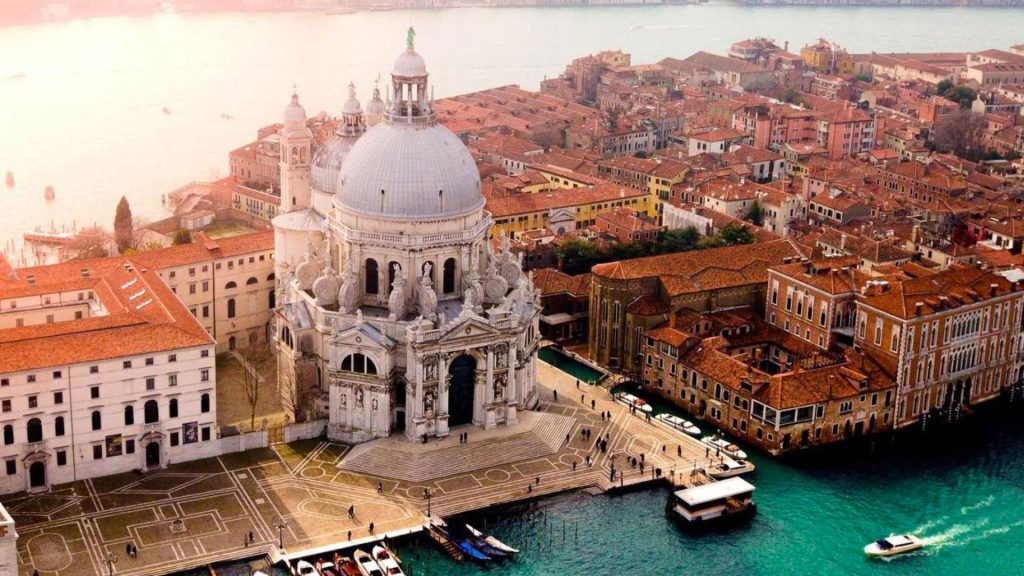
Since 1670, on November 21st, the Venetians pay homage to the Virgin who bestowed healing from the plague upon the city. Over the years, this event has also become a popular feast that brings the entire city together.
Festa della Salute. Known as the less touristic, most authentic, most heartfelt Venetian fete, on every November 21 Venice celebrates Our Lady of Good Health in the form of a simple ritual of religious devotion to a particular instance of Mary’s image, placed at the centre of the main altar at the Salute Basilica. The art had been taken to Venice in 1670 by then-Doge Francesco Morosini and set in place on November 21 of the same year. Why Good Health? Because Venetians owed to her the delivery from the horrible plague of 1630-31. Read closely the Latin inscription: unde origo inde salus – whence its origins, thence its salvation. In the hottest year of recorded history, with the longest summer that doesn’t seem to give way to the next season, it seems almost absurd to remember how November 21 was the day Venetians changed their wardrobe – not into a mid-season one, but decidedly into the warmest set of clothes they had.
If things keep going the way they look, the same day might be the end of the beach season at Lido! Back to the fete: we are not here to rule where exactly religious devotion ends and affection for tradition begins. What is true is that the Salute means belonging, it means community for an urban fabric that use to be so compact, and is now dispersed in several towns miles north of Venice, into the mainland. There’s no question, though, that Venetian will gather and meet by the Basilica in a few short weeks. That’s the strength of the city and its community, the energy of beauty and decadence. A simple Byzantine icon generates, year after year, some social phenomenon that defies the passage of time and looks forward to an optimist future.
THE BASILICA OF “MADONNA DELLA SALUTE” AT PUNTA DELLA DOGANA
An imposingly large staircase seems to rise from the water. Once in, you will see the inside of the double dome construct hovering it. On the top of the larger dome is a statue of the Virgin with the mace of Capitano da Mar (Admiral). Designed by a young Baldassarre Longhena in an innovative Baroque style, the construction of the church began in 1631 and was concluded after Longhena’s death, in 1687. Statues adorn the main façade and the outer sides of the building as well as the inside. The main altar is majestic in its size and is decorated by a marble group by Giusto Le Court. The Virgin Mary appears with the Child in her arms over clouds, puttos at her feet. An angel chases away the plague with a torch while a richly-adorned woman, Venice, reveres the Madonna.
Note: Le Court sculpted an allegory of the plague in the shape of a toothless old hag. Hence, the Venetian saying: you’re ugly as a plague!
THE ICONE OF OUR LADY OF GOOD HEALTH
The icon of Our Lady of Graces, also known as Our Lady of Good Health, was brought to Venice by Doge Morosini in 1670 from St. Titus Cathedral in Candia (present-day Heraklion, Crete). The XIII-century Byzantine plate is highly suggestive for the Madonna’s shadowy face and piercing eyes.
Note: Mesopandotissa is a Greek/Venetian form of Mesoipapantissa, an appellative of the Madonna that originated in Crete that used to signify the feast took place midway (miso) to the Ipapantissa, whose day of celebration is February 2.
THE VOTIVE BRIDGE
Pilgrims can reach the Basilica on foot via the votive bridge, a temporary bridge over the Grand Canal that unites Santa Maria del Giglio and the Basilica.
Note: A chance to see the palaces overlooking the Grand Canal from an unusual perspective.
LIGHTING VOTIVE CANDLES
Venetians are very devoted to Saint Mary up to this day, and you can tell from the number of candles that during the Feast are lit in the church – more than all the other churches in Venice, combined, over a year. Tradition dictates the candles (any number, you get to choose how many) testify your devotion and your plea for good health.
Note: Candles are sold just before the Basilica.
BALOONS AND CANDIED ALMONDS
The sacred and the profane, as is the case with any religious feast, peacefully coexist. Stands sell candy, especially almond brittle and beignets and wait for you after church. Balloons and toys are available for the younger ones.
Note: Eat right away! Why wait?
THE “CASTRADINA”
A plate of Venetian tradition, it is mutton chop, smoked and slow-cooked with savoy cabbage. An homage to the loyalty of the Dalmatians, who, in the long plague induced isolation of Venice, were the only one to send regularly supplies to town and feed the Venetians. Muttons are traditionally raised in their territories.
Note: Beware! Strong tastes ahead.